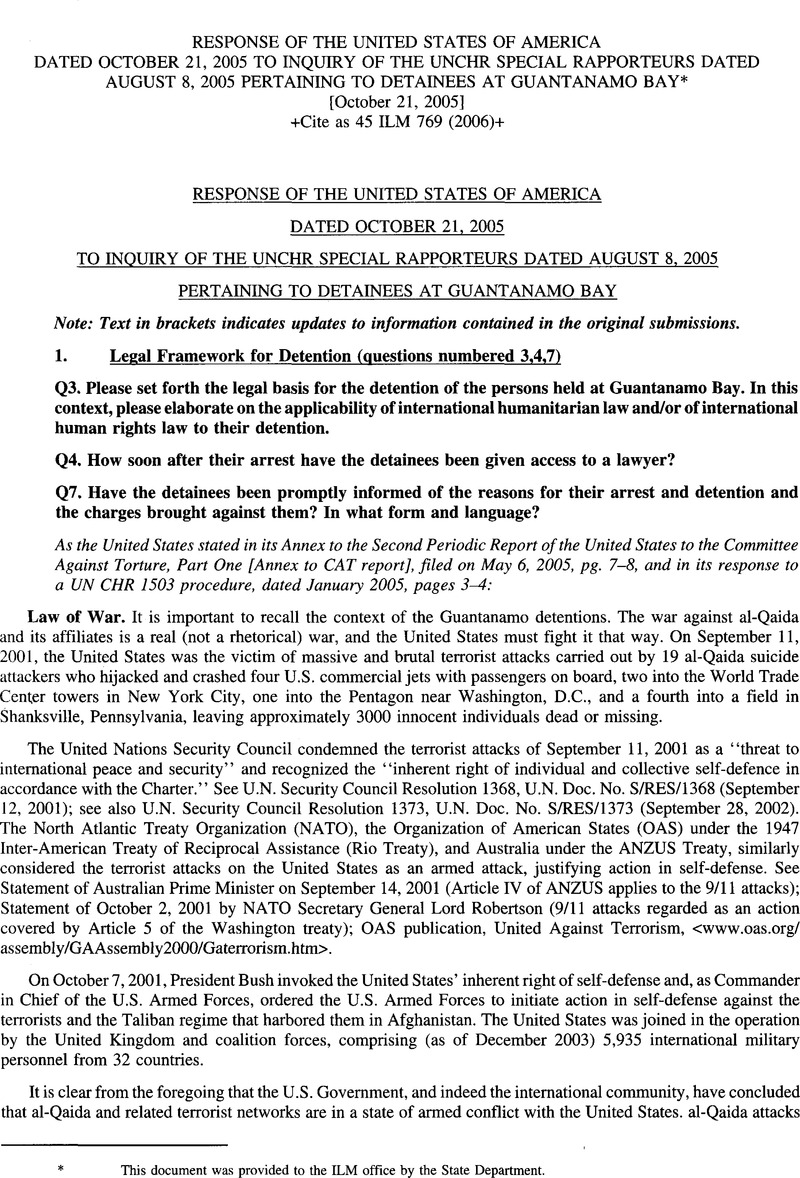No CrossRef data available.
Published online by Cambridge University Press: 27 February 2017

This document was provided to the ILM office by the State Department.
1 See, e.g., Secretary Rumsfeld's statement that the detainees“are not POWs” and instead are “unlawful combatants.“Gerry J. Gilmore, Rumsfeld Visits, Thanks U.S. Troops at Camp X-Ray in Cuba, American Forces Press Service, Jan.27, 2002. (At <http://www.defenselink.miy news/Jan2002/.n01272002_200201271.html> (visited April 11, 2002)).
2 The U.S. Supreme Court, citing numerous authoritative international sources, has held that unlawful combatants “are subject t0 capture and detention, [as well as] trial and punishment by military tribunals for acts which render their belligerency unlawful.” See Exparte Quirin, 317 U.S. 1, 31 (1942) (citing Great britain, war office, manual of military, ch. xiv§§ 445^51; Reqolamento di servizio in guerra, § 133,3 Leggi e decreti del regno d’ Italia (1896) 3184; 7 Moore digest of international law, § 1109; 2 Hyde, international law, §§ 654, 652; 2 Halleck, international law (4th Ed. 1908) § 4; 2 Oppenheim, international law, § 254; Hall, international law, §§ 127, 135; Baty & morgan, war, its conduct and legal results (1915) 172; Bluntschi, droit international, §§ 570 bis).
3 Article 5 states: “Should any doubt arise as to whether persons, having committed a belligerent act and having fallen into the hands of the enemy, belong to any of the categories enumerated in Article 4, such persons shall enjoy the protection of the present Convention until such time as their status has been determined by a competent tribunal.” [emphasis added]. Geneva Convention Relative to the Treatment of Prisoners of War, 6 U.S.T. 3316, T.I.A.S. No. 3364, 75 U.N.T.S. 135, Signed at Geneva 6 on Aug. 12,1949; entered into force on Oct. 21,1950 (entered into force for the United States, Feb. 2, 1956).
4 Department of Defense Memorandum (Jan. 27, 2005).
5 See 10 U.S.C. § 815. The intent of nonjudicial punishment (colloquially referred to as an “Article 15” or “Captain's 7 Mast“) is to provide the commander with enough latitude to resolve a disciplinary problem appropriately in order to maintain “good order and discipline” within the unit. Nonjudicial punishment is designed for minor offenses. It allows a commander to correct, educate, and reform offenders while simultaneously preserving the service member's record of service from unnecessary stigma and furthering military efficiency. A service member is provided appropriate due process rights when considered for nonjudicial punishment. The service member has the right to consult with counsel, the right to remain silent, turn down the nonjudicial punishment and, in turn, possibly face trial by court-martial (unless attached to or embarked upon a vessel), request an open hearing, a spokesperson to speak on the service member's behalf at the hearing, examine all available evidence, present evidence and call witnesses, and, if nonjudicial punishment is imposed, the right to appeal.
6 There has also been an investigation in response to a request by the Australian Government following claims of mistreatment of two Australian detainees at Guantanamo. Although not initially substantiated, the Naval Criminal Investigative Service is conducting an independent investigation into these allegations of abuse.
7 See description, id.